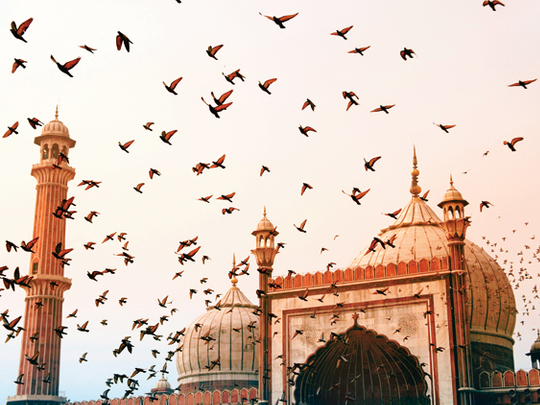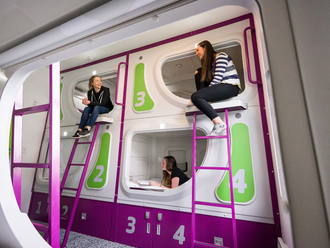
If you thought Bollywood was an illogical, misguided world, blame it all on its beginnings. When the Hindi film industry started out in 1931 with Ardeshir Irani's Alam Ara, it was the only one in the world that did not make films in the language of the region that gave it birth. Put another way, this is as bizarre as the first Chinese language film being made in Thailand. India is, after all, a continent unto itself, with each state functioning like a linguistic island.
So why did films made in Hindi, a language then spoken largely in the northern part of India, get made in Mumbai, where the local language is Marathi? The reason in two words: Dadasaheb Phalke. His — and India's — first film, Raja Harishchandra (1913), was shot in and around the city and the entire industry he kick-started never shifted base.
Mumbai is also India's most energetic, chaotic city, one which owes much of its success to immigrants. As with New York (a Hollywood favourite), this kind of history spawns countless tales of hope and despair, triumph and sorrow, crime and punishment, stories that fascinated and resonated with the film-makers and writers who poured into the city from different parts of India.
As studios cropped up around the city, the industry grew entrenched in Mumbai and key aspects of Mumbai life — the sea, the Ganpati Festival, its dhobi ghat (washing place), its citizens' street-smartness, its women and its rogues — featured in countless movies. (They still do, in fact, right down to the latest blockbuster Agneepath or Kiran Rao's experimental Dhobi Ghat) The song Yeh hai Mumbai meri jaan (This is Mumbai, my darling) from the film C.I.D. became Hindi cinema's ode to the city of its birth. A more recent tribute to the region is the remake of the popular Marathi song Kombadi Palali starring Katrina Kaif clad in a lugade (nine-yard Marathi sari) as Chikni Chameli in Agneepath (see page 26).
Soon there were stretches of Mumbai — such as the promenades at Marine Drive and Carter Road, the steps of the Asiatic Library or Madh Island (a location especially favoured by screen dons of the 80s) that were so frequently photographed that even viewers outside the city began to recognise them.
Of course, film-makers explored other Indian cities and locations, especially when the story demanded it. But more often than not, Delhi or any other location was just a backdrop and not integral to the story. Besides, song sequences demanded picturesque locales and there was a time when it was near mandatory for any big movie to shoot at least one song in Kashmir's snow-covered slopes. Would Shammi Kapoor's iconic ‘Yahoo!' song from Junglee have worked better anywhere else?
The exodus begins
But some ten to 15 years ago, Mumbai's pre-eminence began to fade as a result of short-sighted urban policies, an unmanageable population and some of the highest realty rates in the world. The city saw a gradual exodus of industries — from manufacturing and software to fashion, art and restaurants. The last three moved mainly to Delhi. And suddenly the country's political capital became a more happening place than the commercial capital. It was around this time that Delhi began to crop up increasingly in Hindi cinema. And audiences up north (who form a big chunk of box-office collections) loved it. Once there was commercial validation for the trend, the rest was predictable.
Delhi may not have the long-established film-making infrastructure that Mumbai does, but there are other compensations. For one, beautiful settings that go from the Lodhi Gardens and photogenic monuments to the latest cinematic favourite, the Metro. The Delhi Metro Rail Corporation has welcomed film-makers and scenes from films such as Love Aaj Kal, Paa and Delhi 6 have been shot there. The swanky new Airport Express line is the latest magnet and Shah Rukh Khan even hopped on to the Metro to promote his films Ra.One and Don 2 (it would be a brave film star who would attempt to board a Mumbai local even during off-peak hours).
Mumbai's infamous traffic jams and hyper-inflated real estate prices, both increasing by the day, have also done it in. Delhi not only offers broad avenues to shoot street scenes in, it also has sprawling bungalows and farmhouses that rent for anything from Rs50,000 to Rs100,000 (about Dh3,641 to Dh7,283) or less per day as compared to twice that and more in Mumbai.
Delhi's city fathers, smelling an opportunity, are now talking of a single-window clearance for the bane of all film-makers, the various permissions required to shoot. If that does happen, Delhi-bound traffic is bound to boom.
Hitherto unexplored
The last few years have seen a number of big movies set in Delhi. Leading the brigade is Rakeysh Omprakash Mehra whose Rang De Basanti and Delhi 6 went beyond the touristy montages of Parliament House and the Qutub Minar; his stories were set amid the bustle and chaos of everyday Delhi. "All cinema is deeply personal," he declares, "and for me, all dots meet in Delhi." The two films are full of vignettes from his childhood and college days, he says: "Many of the incidents in those two movies have actually happened to me."
Dibakar Banerjee, who also grew up in Delhi, took another route into the city's mindset and specificities. His debut, the delightful Khosla ka Ghosla, dealt with the Delhi phenomenon of shady land deals. His next, Oye Lucky, Lucky Oye, used one of Delhi's most popular Punjabi nicknames, Lucky, for his protagonist, a quick-witted conman. The story was based on a real-life Delhi trickster who is said to have burgled more than 100 showrooms and 300 homes in Delhi.
Rajkumar Gupta's No One Killed Jessica was based on the sensational case of pretty young Jessica Lal who was shot dead at a party bar by a Delhi politician's son because she refused him a drink after closing hours.
Of course, the film had to be set in Delhi, but Gupta captured the city's attitude to power and politicians most powerfully through the eyes of a cynical police officer.
And then there was Band Baaja Baaraat, which plunged deeper into the city's social layers with the story of two ambitious wedding planners who want to move up the social scale. >
As its director Maneesh Sharma puts it, the film "brought out new textures to Delhi, went into areas [geographical and otherwise] that had not been explored before. And those textures were visually authentic."
Band Baaja Baaraat steered clear of popular or even pretty images of the city. Recalls Sharma, "The seed idea was the girl's journey from middle-class Janakpuri to the plush Sainik Farms. So the first thing I told my cinematographer was that we would not be shooting at the Red Fort or Humayun's Tomb. I grew up in Pitampura, not too far from Janakpuri, so I was just being honest to her story and my own experiences." Coincidentally, Habib Faisal, who wrote the screenplay and dialogue for Band Baaja Baaraat, put out his own film, Do Dooni Char, in the same year. A warm, touching story of a principled schoolteacher trying to put together the money to buy a car, it could have been set in any Indian metro. But Faisal is a Delhi-ite or Dilliwallah in local parlance, and he stuck to the milieu he knew best.
Another local boy is Imtiaz Ali, director of Love Aaj Kal and the recent Rockstar, both with strong Delhi segments. But it was the Mumbai-born Abhinay Deo who took one of 2011's best films, Delhi Belly, a scatological caper, to the capital and showed viewers Delhi in a fascinatingly seedy light. The film's toilet humour offered a hilarious visual interpretation of the phrase that has become synonymous with a runny tummy for all tourists coming to India. Indeed, many of the film's viewers, including locals, were virtual tourists in the grimy, dilapidated slice of Delhi that Deo showed them.
Which is why, perhaps, Maneesh Sharma, who knows his city, declares: "Cinematically speaking, Delhi is still largely unexplored."








